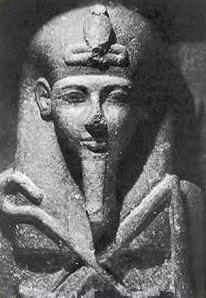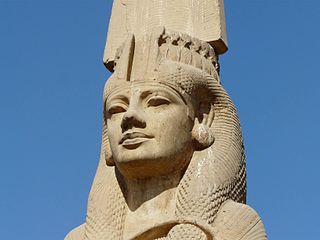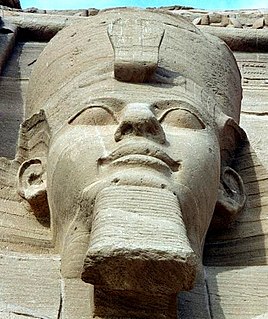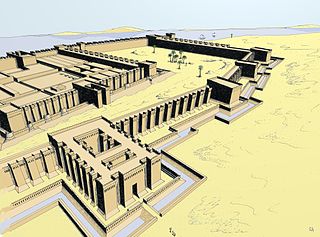
Nefertari, also known as Nefertari Meritmut, was an Egyptian queen and the first of the Great Royal Wives of Ramesses the Great. Nefertari means 'beautiful companion' and Meritmut means 'Beloved of [the goddess] Mut'. She is one of the best known Egyptian queens, next to Cleopatra, Nefertiti, and Hatshepsut. She was highly educated and able to both read and write hieroglyphs, a very rare skill at the time. She used these skills in her diplomatic work, corresponding with other prominent royals of the time. Her lavishly decorated tomb, QV66, is one of the largest and most spectacular in the Valley of the Queens. Ramesses also constructed a temple for her at Abu Simbel next to his colossal monument there.

Seti II was the fifth ruler of the Nineteenth Dynasty of Egypt and reigned from c. 1200 BC to 1194 BC. His throne name, Userkheperure Setepenre, means "Powerful are the manifestations of Re, the chosen one of Re." He was the son of Merneptah and Isetnofret II and sat on the throne during a period known for dynastic intrigue and short reigns, and his rule was no different. Seti II had to deal with many serious plots, most significantly the accession of a rival king named Amenmesse, possibly a half brother, who seized control over Thebes and Nubia in Upper Egypt during his second to fourth regnal years.

Herihor was an Egyptian army officer and High Priest of Amun at Thebes during the reign of Pharaoh Ramesses XI.

Akhenre Setepenre Siptah or Merenptah Siptah was the penultimate ruler of the Nineteenth Dynasty of Egypt. His father's identity is currently unknown. Both Seti II and Amenmesse have been suggested although the fact that Siptah later changed his royal name or nomen to Merneptah Siptah after his Year 2 suggests rather that his father was Merneptah. If correct, this would make Siptah and Seti II half-brothers since both of them were sons of Merneptah.

Meritamen was a daughter and later Great Royal Wife of Pharaoh Ramesses the Great.

Pinehesy, Panehesy or Panehasy, depending on the transliteration, was Viceroy of Kush during the reign of Ramesses XI, the last king of the Egyptian 20th Dynasty.

The Ancient Egyptian Noble Paser was vizier, in the reigns of Seti I and Ramesses II, during the 19th dynasty. He would later also become High Priest of Amun.

Wadi es-Sebua, or Valley of the Lions, is the site of two New Kingdom Egyptian temples, including one speos temple constructed by the 19th dynasty Pharaoh Ramesses II, in Lower Nubia. The first temple was built by the 18th dynasty Pharaoh Amenhotep III and subsequently restored by Ramesses II. In its first stage, this temple "consisted of a rock-cut sanctuary fronted by a brick-built pylon, a court and a hall, partly painted with wall paintings." The temple was perhaps dedicated to one of the local Nubian forms of Horus, but his representations were altered to Amun at a later point in time. During the Amarna period, images of Amun were attacked and the decorations deteriorated but Ramesses II later restored and extended Amenhotep III's temple by building structures in front of the pylon.
Seti or Suti was an ancient Egyptian soldier during the late 18th Dynasty, the commander of the army, later mentioned as vizier on monuments of his son, Pharaoh Ramesses I.
Ahmose called Turo was Viceroy of Kush under Amenhotep I and Thutmose I.

Amenemopet served as Viceroy of Kush during the reign of Seti I.
Paser I was the Viceroy of Kush during the reigns of Ay and likely Horemheb. Reisner mentions that the only datable inscriptions for Paser belong to the reign of Ay. The next known Viceroy however is Amenemopet, who is dated to the reign of Seti I. Hence it's possible that Paser I served during the reigns of Ay, Horemheb

The Viceroy of Kush Seti is attested in year 1 of Siptah. Seti is also mentioned on some monuments of his son Amenemhab. Amenemhab was the son of Seti and the Lady Amenemtaiauw. Seti held the titles fan-bearer on the king's right, and king's scribe of the letters of the Pharaoh. His son Amenemheb served as Head Bowman, Charioteer of His Majesty, and Overseer of the Southern Lands.
Hori II is a son of Hori I and also served as Viceroy of Kush. Their tombs have been found in Tell Basta. Hori II may have been the father of a later Viceroy named Wentawat.

Wentawat, was Viceroy of Kush under Ramesses IX, during the 20th Dynasty. He was a son of the Viceroy Nahihor.

The Theban Tomb TT214 is located in Deir el-Medina, part of the Theban Necropolis, on the west bank of the Nile, opposite to Luxor.
Nakhtmin was a Troop Commander of Kush and Royal Envoy to Every Foreign Land during the reign of Ramesses II.

Tia was an ancient Egyptian high official under king Ramses II. His main title was that of an overseer of the treasuries. Tia was married to a woman with the same name, the princess Tia who was sister of Ramses II.

Yuni served as Head of the-stable-of-Seti-I, Charioteer of His Majesty, and Chief of the Medjay before becoming Viceroy during the reign of Seti I. He would use some of these titles simultaneously. On a stela from Abydos -now in the Cairo Museum - the inscription reads:



















